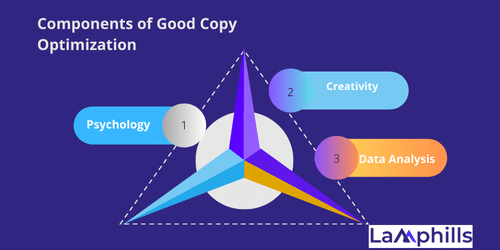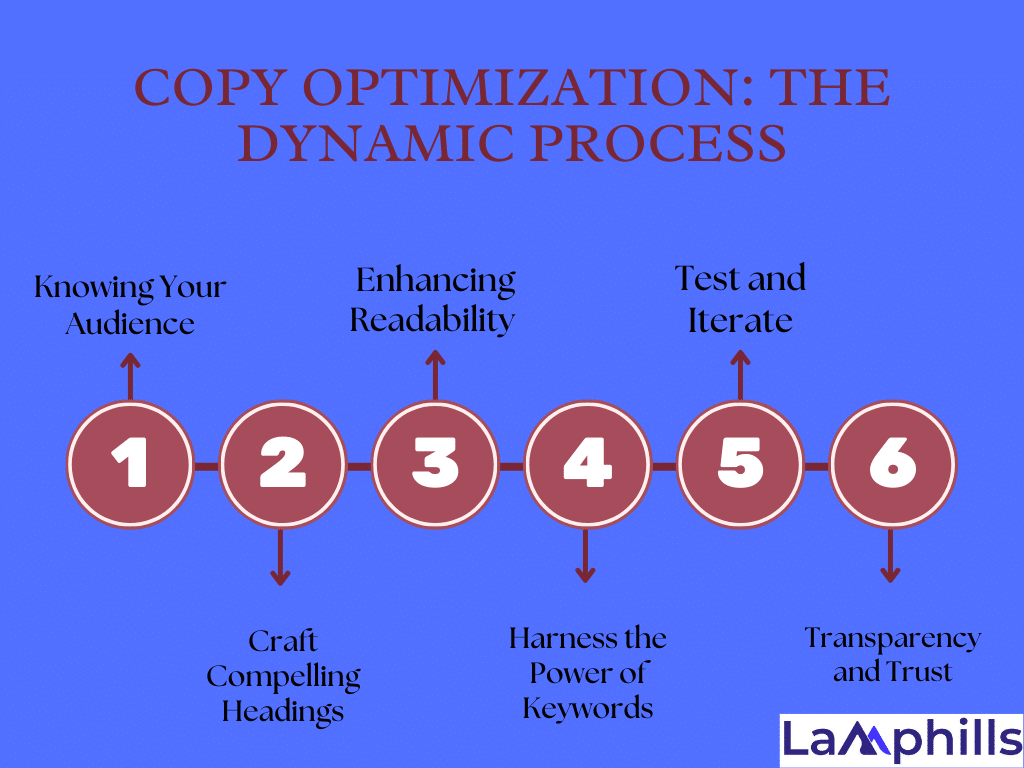I remember the first time I understood the very essence of an optimized copy. I was entrusted with redesigning a small startup’s website a few years ago. We had a fantastic product, but our internet traffic remained static, and our conversion rates were appalling. Frustrated and anxious for an answer, I came upon the concept of copy optimization. I had no idea that this finding would affect everything. Within months of employing copy optimization strategies, our website traffic had doubled, and our conversion rates had soared. This event demonstrated to me the huge effect that well-optimized copy can have on commercial success.
In this article, I’ll share the proven techniques I’ve learned over the years that can transform your writing and drive significant business growth. Whether you’re a seasoned writer or just starting, these strategies will help you craft content that not only engages your audience but also drives measurable results.
Key Takeaways
- To effectively optimize your writing, focus on three core aspects: understanding your audience deeply, infusing creativity into your content, and leveraging data insights. By mastering these elements, you can create compelling content that resonates with your specific business audience and drives meaningful engagement.
- Emphasizing transparency, honesty, and inclusivity in your writing is crucial. These ethical considerations not only build trust with your readers but also align your content with the values of your audience. Incorporating sustainability messaging where relevant can also resonate deeply with today’s conscientious consumers.
- By continuously refining your writing skills and adapting to audience preferences, you can enhance your content’s effectiveness and achieve significant business growth through improved engagement and conversions.
What is Copy Optimization?

Copy optimization means changing your text to make it more effective in attaining specific objectives, such as increasing engagement, improving SEO, or driving conversions. It is about making your content more efficient and effective. Consider it like tuning a car engine: the more precisely tuned it is, the better it runs.
This is because optimized text can have a huge impact on your business. It promotes your website’s visibility in search engines, improves user experience, and, eventually, increases your profits. According to a HubSpot study, firms that emphasize content optimization have a 13 times better ROI than those that do not.
Copy Optimization Basics. What is a Copy?
In the broad field of digital marketing, the term “copy” is heavily used. It is the foundation of brand-consumer communication—the hinge that can transform a casual browser into a dedicated customer. But what exactly is copywriting, and why is it so important in marketing and advertising?
Copy is defined as any written information prepared with the specific goal of persuading, informing, or engaging an audience. This includes a diverse set of materials such as website content, blog articles, social media updates, email newsletters, advertising, and product descriptions. Essentially, any words used to communicate a message and provoke a response are regarded as a copy.
Words can elicit emotion, arouse curiosity, and motivate action. This is why effective copywriting uses words strategically to impact how people think and feel. Every word counts in the world of copywriting, whether it’s writing a fascinating headline that captures readers’ attention, presenting a story that resonates with them, or creating a strong call to action that drives clicks.
In other words, copy reigns supreme in the realm of digital marketing. It’s the driving force behind great campaigns, the glue that holds your brand messaging together, and the key to building a stronger connection with your audience. By knowing the principles of copy optimization and applying them to your marketing efforts, you can create compelling content that resonates with your audience and drives results. Before we proceed, let’s first take a closer look at what the 3 basic conditions for good copy optimization are.
Foundational Components of Good Copy Optimization

Copy optimization is at the heart of successful communication initiatives. It’s more than just stringing words together; it’s a complex process of fine-tuning content to resonate profoundly with your target audience, ultimately motivating them to take the required action. At its core, copy optimization is a smart combination of psychology, creativity, and data analytics. Let us take a closer look at each of the three components:
#1. Psychology
Understanding the psychological triggers that influence human behavior is paramount to crafting persuasive copy. By tapping into emotions, desires, and pain points, copywriters can establish a strong connection with the audience. Whether it’s leveraging the fear of missing out (FOMO), appealing to aspirations, or addressing common frustrations, psychology serves as the foundation for effective messaging.
#2. Creativity
While psychology offers structure, creativity gives the spark that drives engagement. Creative copywriting entails thinking beyond the box, discovering new angles, and weaving narratives that capture the audience’s interest. Storytelling is one of the most effective things a copywriter can use.
Humans are hardwired to respond to tales, and a well-crafted narrative can captivate attention, elicit emotion, and motivate behavior. Whether you’re writing a sales website, a social media post, or an email campaign, telling a fascinating tale will help make your message more memorable and persuasive. Originality breathes life into copy optimization, making it memorable and successful. This can be accomplished through visually appealing language, smart wit, or compelling storytelling.
#3. Data Analysis
Although there is great discussion regarding what constitutes scientific proof, educated decisions reign supreme today. Data analysis is essential for copy optimization since it provides significant insights into audience preferences, behaviors, and trends. Marketers may optimize their messaging by using analytics tools, A/B testing, and user feedback. Data-driven optimization guarantees that each word serves a purpose, resulting in greater conversion rates and ROI.
Copy Optimization: The Dynamic Process

As you will be seeing below, successful copy optimization is not a one-size-fits-all method. It is a dynamic process that requires ongoing refinement and adaptation. Marketers can design messages that resonate profoundly with their audience and motivate them to take action by combining psychological principles with creative ingenuity and data-driven insights. Whether it’s boosting sales, generating leads, or raising brand awareness, copy optimization enables businesses to cut through the clutter and form meaningful relationships with their target audience.
#1. Knowing Your Audience
Understanding your audience is essential for crafting good copy. Create thorough buyer personas to obtain a better understanding of who you’re writing for. Think about their wants, preferences, and pain spots. For example, if you’re targeting small business owners, your material should address their unique difficulties, such as limited resources or the need for low-cost marketing solutions.
Before we go into the intricacies of this article’s specific subject, copy optimization, let us first examine the psychology component described above, as understanding your target audiences is indeed the key to success. Understanding your target audience is the first step in creating an effective communication strategy. Taking the time to thoroughly comprehend your target demographic is paramount when it comes to copy optimization. Here’s how:
A. Identifying Pain Points
Every audience faces unique obstacles and pain spots. These are the roadblocks that impede their advancement or bring difficulty in their life. However, by identifying these pain points, you receive vital insights into the exact areas for which your expertly edited copy can provide remedies. To do this, conduct surveys, interviews, or social media listening to directly identify these pain points among your audience. It may sound strange to hear it defined in this manner, but a healthy copy thrives on suffering. (Poor, poor copy)
B. Understanding Desires and Aspirations
Effective text optimization goes beyond resolving pain points to delve into the audience’s goals and desires. What are their dreams? What do they want to achieve? By connecting your messaging with these ambitions, you establish a strong emotional connection with your audience. Use stories and visuals to elicit the desired emotions and help your audience see a brighter future with your offer. Emotion has a huge impact on decision-making. By appealing to your audience’s emotions, you might generate a sense of urgency, excitement, or desire, compelling them to act. Emotional appeals, whether motivated by fear of missing out (FOMO), the thrill of solving a problem, or the satisfaction of attaining a goal, may be extremely compelling.
Scarcity can be a powerful psychological trigger that motivates people to act quickly, too. By highlighting limited quantities, deadlines, or exclusive offers, you can create a sense of urgency that drives immediate action. Whether it’s a limited-time sale, a countdown timer, or a “while supplies last” message, scarcity can compel your audience to decide before it’s too late.
C. Balancing Emotion and Logic
While emotions often drive initial engagement, it’s essential to also appeal to your audience’s logical reasoning. Provide clear and rational arguments to support your claims, address potential objections, and present evidence to back up your assertions. By appealing to both emotion and logic, you can create a persuasive argument that resonates with a broader audience.
D. Uncovering Motivations
Motivations drive action. Whether it’s the desire for success, the need for convenience, or the pursuit of happiness, understanding what motivates your audience can inform your copy optimization approach. Craft messages that speak directly to these motivations, highlighting how your offering fulfills their needs and propels them toward their goals.
E. Utilizing Social Proof
People are more likely to trust and follow the actions of others. Social proof, such as testimonials, case studies, and user reviews, can provide validation and credibility to your claims. Incorporating social proof into your copy can help alleviate skepticism and build trust, making it easier to persuade your audience to take the desired action.
F. Speak Their Language
Language is a powerful tool for connection. To truly resonate with your audience, you must speak their language—both literally and figuratively. Pay attention to the words, phrases, and expressions commonly used by your target demographic. Incorporate this language into your copy to create a sense of familiarity and authenticity that builds trust and rapport.
Let’s say you’re optimizing copy for a fitness product targeted toward busy professionals in their 30s who are looking to improve their health and fitness without sacrificing time. Here’s an example of how you might adjust the language to better resonate with this audience.
Optimized copy for the target audience: “Achieve your fitness goals in just 30 days, despite your hectic schedule! Our tried-and-true approach is created just for professionals like you, making it easier than ever to prioritize your health without adding unnecessary stress to your day.”
As you can see from this improved version, the wording communicates directly to the target audience by acknowledging their hectic lifestyles and providing a solution that meets their demands. It is critical to select terms and phrases that the audience can relate to and comprehend, which will make the copy more appealing and persuasive. Don’t forget: that customization is essential.
#2. Craft Compelling Headings
Your headline is the first thing readers see, so it must capture their attention. Use strong language and promise that your material will be delivered. For example, “Transform Your Writing with Copy Optimization: Proven Techniques for Business Success” promises consumers practical tips for improving their writing.
Crafting appealing headlines is an art form that can determine the success of your content. Your headline is the introduction to your content, inviting visitors to learn more about what you have to offer. Here’s how to create enticing headlines:
A. Conciseness
Keep your headline short and sweet. Aim for around 6–8 words, if possible. This ensures that your message is clear and easily digestible at a glance.
B. Specificity
Be specific about what your content offers. Vague headlines might spark curiosity, but specific ones instantly communicate value. For example, instead of “Ways to improve your writing,” try “7 proven techniques to enhance your writing skills.”
C. Clear Benefit or Solution
Highlight the benefit or solution your content provides. Readers want to know what’s in it for them. Whether it’s saving time, learning something new, or solving a problem, make it explicit in your headline.
D. Power Words
Powerful words are persuasive and evoke emotion. Words like “ultimate,” “guaranteed,” “effortless,” or “essential” can add impact to your headlines, making them more compelling.
E. Numbers
Incorporating numbers into your headline adds structure and promises a specific amount of information. Odd numbers tend to perform better than even ones, and using digits instead of spelling out the numbers, as we also do in this blog post, can increase readability.
F. Emotional Triggers
Just think of the things we wrote about the role of psychology! Appeal to your audience’s emotions: whether it’s curiosity, fear of missing out (FOMO), excitement, or a desire for improvement, tapping into emotions can make your headlines more captivating.
By combining these elements, you can surely create headlines that grab attention, pique curiosity, and compel readers to click through to your content. Remember, your headline is your first impression, so make it count!
#3. Enhancing Readability
It is more difficult than ever to capture and hold readers’ attention. To succeed in this environment, readability must be prioritized. We can make our communications more accessible and interesting to a larger audience by splitting up text into manageable pieces, using clear subheadings, and integrating plenty of white space. Let’s look at some practical ways to improve readability!
A. Breaking Up Content
Long paragraphs can overwhelm readers and deter them from engaging with your content. To combat this, break up your copy into smaller, digestible chunks. (Take an example from this blog post!) Aim for paragraphs of no more than 3–4 sentences each. This not only makes your content easier on the eyes but also encourages readers to keep scrolling.
B. Utilizing Subheadings
Subheadings act as signposts, guiding readers through your content and helping them navigate complex topics. Use descriptive subheadings to summarize the main points of each section. This allows readers to quickly scan the post and locate the information that is most relevant to them.
C. Incorporating White Spaces
Good formatting improves your content’s accessibility and engagement. To break up the material, add small paragraphs, bullet points, and graphics. This makes your information easy to read and retains the reader’s interest. For example, this essay employs subheadings and bullet points to help readers navigate the text.
White space, or the space between text and images, is critical to improve readability. It gives readers’ eyes a break and helps them concentrate on the information. Avoid overloaded layouts and the excessive use of photos or graphics to ensure that your post has enough white space.
D. Using the Buyer’s Journey
By optimizing your copy to align with each stage of the buyer’s journey—awareness, consideration, and decision—you can guide potential customers from initial interest to final conversion.
- Awareness stage
At the awareness stage, your audience is just beginning to recognize their pain points and search for potential solutions. This is your opportunity to educate them about their challenges and offer valuable insights. Focus on addressing common pain points, providing useful information, and showcasing your expertise to capture their attention. - Consideration stage
As your audience moves into the consideration stage, they are actively seeking solutions to their problems. Now is the time to showcase how your product or service can address their specific needs. Highlight key features, benefits, and case studies that demonstrate the value you can provide. By offering relevant information and demonstrating your expertise, you can help your audience evaluate their options and move closer to making a decision. - Decision stage
In the decision stage, your audience is ready to make a choice. This is your moment to shine. Emphasize the unique benefits and selling points of your offering to differentiate yourself from the competition. Use persuasive language (and compelling visuals) to drive home the value proposition and inspire action. By clearly communicating the benefits of choosing your offer, you can motivate your audience to take the final step toward conversion.
E. Simplifying Languages
Maintain a consistent tone and voice that reflects your brand. If your brand is professional, your writing should reflect this. If the tone is informal and welcoming, so should your writing. For example, this article adopts a conversational tone to make the subject more approachable and engaging.
In a world overflowing with knowledge, simplicity is essential. Use plain, uncomplicated language that readers can understand. Avoid using superfluous jargon and technical phrases that could alienate or confuse your readers. Remember, the goal is to get your message over to as many individuals as possible.
Incorporating these tactics into your writing can greatly improve the readability of your content. Breaking up material, utilizing informative subheadings, adding white space, and simplifying language, can create a more enjoyable and accessible reading experience for your audience. The next time you sit down to optimize copy, remember to prioritize readability—it’s the key to capturing and keeping your readers’ attention.
#4. Harness the Power of Keywords
Keywords act as guiding stars, directing both search engines and users to your digital doorstep. They’re not just words; they’re the lifelines connecting your content to the audience seeking it. Understanding and harnessing the power of keywords can catapult your text from obscurity to prominence, amplifying its reach and impact.
A. The significance of Keywords
Keywords serve as the foundation of search engine optimization (SEO), the cornerstone upon which your digital presence is built. They are the terms and phrases that users input into search engines when seeking information, solutions, or products. By optimizing your copy with these keywords, you make it more discoverable to those actively seeking what you offer.
B. The Art of Keyword Research
Effective keyword integration begins with meticulous research. It’s not just about identifying popular terms but also understanding the intent behind them. Tools like Google Keyword Planner, SEMrush, or Moz Keyword Explorer can provide invaluable insights into search volume, competition, and related terms. Cannot be overemphasized: delve into your audience’s psyche, anticipate their queries, and uncover the language they use to express their needs and desires.
C. Strategically Placing Keywords
Keywords should seamlessly weave into your content’s fabric, enhancing its readability and relevance rather than interrupting it. Aim for a natural flow, integrating keywords into headings, subheadings, and body text while maintaining coherence and readability. Remember, search engines prioritize content that not only contains keywords but also provides value and engages readers.
D. Long-Tail Keywords
While popular keywords attract significant traffic, long-tail keywords often hold untapped potential. These are longer, more specific phrases that may have lower search volumes but higher conversion rates. Embrace the power of long-tail keywords to target niche audiences and capitalize on their specific needs and preferences.
E. Monitoring And Adaptation
SEO is a dynamic landscape that evolves in tandem with search engine algorithms and user behavior. Monitor your keyword performance regularly by employing analytics tools to track ranks, traffic, and engagement. Be prepared to adjust your keyword strategy as needed, tweaking your material to match developing trends and changing audience preferences.
Keywords serve as your compass, directing both search engines and users to your virtual doorstep. Mastering keyword integration is more than just a technical skill; it’s a strategic essential for increasing your online exposure and boosting organic traffic. By completing thorough keyword research, intelligently arranging keywords, and responding to shifting dynamics, you can maximize your content optimization’s potential and rocket it to new heights of success in the digital ecosystem.
#5. Test and Iterate
Testing and iteration in the realm of digital marketing, particularly concerning copy optimization, is akin to fine-tuning a symphony. Each element, from the choice of words to the structure of sentences, plays a crucial role in orchestrating the desired response from your audience. Here’s a closer look at how this process unfolds:
A. Identifying Key Variables
Before diving into testing, it’s imperative to identify the variables you want to test. These could include different headlines, body copy variations, calls-to-action (CTAs), tone of voice, and even visual elements if applicable. Each of these components can have a significant impact on how your audience perceives and engages with your message.
B. Setting Clear Objectives
Define clear objectives for your testing process. Are you aiming to increase click-through rates, boost conversions, or enhance brand recall? Establishing these goals will guide your experimentation and help measure the effectiveness of different copy variations.
C. A/B Testing
A/B testing entails developing two versions of your content and testing them to determine which performs better. For example, you could compare two distinct headlines to see which one generates more clicks. This allows you to fine-tune your copy and increase its efficacy over time.
A/B testing, which was discussed earlier in the section “Data analysis,” is a widely used strategy in which you generate two or more versions of your content, each with a single difference, and then test them against each other to see which performs better. For example, you may test two different headlines to determine which one gets more hits or conversions.
D. Multivariate Testing
In situations where you want to test multiple variables simultaneously, multivariate testing comes into play. This approach allows you to analyze the interaction effects between different elements of your copy. While more complex to set up and analyze, multivariate testing can provide deeper insights into how various elements interact with each other.
F. Gathering Data
Once your tests are live, gather relevant data using analytics tools such as Google Analytics, Adobe Analytics, or platform-specific analytics tools (e.g., Facebook Insights). Pay attention to metrics like click-through rates, conversion rates, bounce rates, and engagement metrics to gauge the performance of your copy variations.
G. Drawing Insights
Analyze the data collected during your tests to identify patterns and insights. Which copy variation performed better? Are there any unexpected findings? Understanding these insights will help you make informed decisions about refining your copy strategy.
H. Optimizing and Iterating
Based on the insights drawn from your tests, optimize your copy accordingly. Implement the learnings from successful variations into your ongoing marketing efforts. However, the process doesn’t end here. Continuous iteration is key to staying relevant and adapting to changing audience preferences and market dynamics.
I. Continuous Monitoring
You can make reference to the checklist below
Constant iteration is followed by ongoing monitoring. Digital marketing is dynamic, and what works today may not work tomorrow. As a result, it is critical to regularly analyze the performance of your content and be ready to adjust based on emerging trends, shifts in consumer behavior, or changes in your competitive landscape.
In essence, testing and iteration in copy optimization is a dynamic and ongoing process that requires a combination of creativity, data analysis, and agility. By embracing experimentation and continuously refining your approach, you can effectively engage your audience, drive conversions, and remain in the lead.
#6. Transparency and Trust
Customers today place a higher emphasis on openness than ever before. Being transparent in your copy is being upfront and honest about your business, products, or services. It entails giving factual information, identifying any potential biases or conflicts of interest, and being completely transparent about pricing, terms, and conditions. This is because transparency fosters genuine connections with your audience, resulting in long-term customer loyalty and advocacy.
A. Balancing Persuasion and Honesty
Copywriters often walk a fine line between persuasion and honesty. While it’s essential to craft compelling copy that persuades readers to take action, it’s equally important to maintain integrity and honesty in your messaging. Avoiding deceptive tactics or exaggerated claims ensures that your copy remains credible and trustworthy. By striking the right balance between persuasion and honesty, you can effectively communicate your brand’s value proposition while respecting the intelligence and discernment of your audience.
B. Diversity and Inclusion
Diversity and inclusion are not only ethical imperatives but also essential aspects of effective copy optimization. Reflecting the diversity of society in your copy demonstrates your brand’s commitment to inclusivity and equality. This means representing people from various backgrounds, cultures, identities, and perspectives in your messaging. By embracing diversity and inclusion in your copy, you can resonate with a broader audience, foster a sense of belonging, and contribute to positive social change.
C. Aligning Values with Brand Communication
As environmental and social issues grow more relevant to customers, brands must integrate their values into their communication strategy. The sustainability message communicates your brand’s dedication to environmental care, social responsibility, and ethical business practices. This could involve emphasizing eco-friendly projects, ethical sourcing techniques, and corporate social responsibility activities in your copy. By connecting your principles with your brand communication, you can attract aware consumers who value sustainability and ethical consumerism.
Ethical considerations can have a significant impact on text optimization, from increasing trust and authenticity to fostering diversity and inclusion and aligning with sustainable principles. Prioritizing ethics in your copy optimization methods allows you to make meaningful relationships with your audience while maintaining your brand’s integrity and reputation.
What is SEO copywriting?
SEO copywriting is the practice of producing keyword-optimized content that’s designed to appeal to human users and search engine algorithms
What does SEO mean?
Search engine optimization (SEO) is the practice of orienting your website to rank higher on a search engine results page (SERP) so that you receive more traffic.
What are the best tools for gathering user feedback?
Popular tools for gathering user feedback include SurveyMonkey, Typeform, Qualtrics, and Hotjar. These tools allow you to create surveys, polls, and feedback forms to collect valuable insights directly from your audience.
How do I measure the success of my copy optimization efforts?
Measure success by tracking key performance indicators (KPIs) such as conversion rates, click-through rates, bounce rates, time on page, and engagement metrics. Compare these metrics before and after implementing changes to assess their impact.
Conclusion
Reflecting on my experience with copy optimization, I’ve witnessed directly how employing these methods can impact business outcomes. From small startups to established businesses, the fundamentals of efficient text optimization have continuously propelled development and success. Whether you want to boost your internet visibility, improve revenue, or strengthen client connections, an optimized copy is essential for success.
Now that you’ve mastered the tried-and-true strategies of copy optimization, it’s time to apply them. Examine your existing material to uncover areas for optimization. Remember that copy optimization is a continuous process of trial and refinement. The more you understand your audience and tailor your material to their demands, the more successful your efforts will be. So what are you waiting for? Begin optimizing your text immediately and watch your company reach new heights of success!






